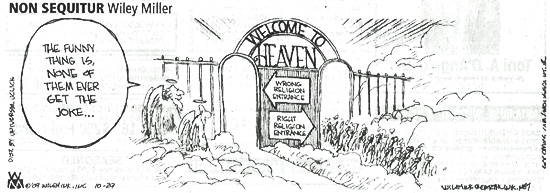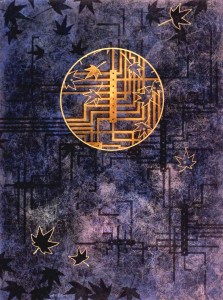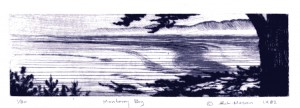Archive for March, 2009
The Printmaker
(click on image for larger view)
Kristin Lindseth in the print room of the Pacific Art League of Palo Alto.
Searching for Truth
I was raised a Christian of Protestant persuasion. After a number of years of Sunday school my parents sent me to membership classes which I attended faithfully and was confirmed by a concluding communion service as a full-fledged member.
I remember that during the membership classes I was troubled by a reoccurring thought that I couldn’t seem to get out of my head. I would sit there listening to the instructor (the minister’s wife) tell us the “right” way to believe, and I would imagine a similar class taking place on the other side of the world where a Hindu instructor was telling little candidate Hindus the “right” way to believe. I was sure that these two “right” ways were probably different enough that they couldn’t both be “right.” I suppose some people would simply pass off this difficulty by saying that we are right because we are who we are (naturally superior) and they are wrong because they are who they are. Somehow I could never bring myself to use that argument, not even in my own private thoughts.

There are, of course, many “right” ways to believe, and many of them are contradictory or mutually exclusive. When I raised this problem in the membership class I was told “what they believe is right for them, and what we believe is right for us.” This didn’t make me feel much better. It made truth entirely subjective, and it seemed to me that a great word like “truth” deserved better than that. I could understand how a certain amount of cultural relativity must be necessary concerning the laws needed to govern a civilized society, but when it came to defining the ultimate nature of reality I was convinced there could be only one right answer.
None of my fellow students seemed to be bothered by this problem, or if they were, they kept it to themselves. I went ahead and completed the indoctrination to please my parents, but it became clear to me at that time that I would be unable to swallow any predigested orthodoxy in its entirety. I would have to decide for myself those tenets which I would believe and those which I would reject. And where I couldn’t decide, I would just have to reserve judgment for a while. It was going to be a long process. So I became eclectic in my beliefs, picking and choosing as I gained experience and hoped that someday I would be able to see a pattern that would make things easier.
Right from the first I discovered it was not easy to be eclectic. You had to think. Plus, it took some fortitude to say “I don’t know,” when everyone else was buying the canned answer. But after a while, I grew interested in the problem, and actively pursued my own personal research. I noticed that most religions seemed to have two major parts. There was the system of morals and ethics which they advocated as proper behavior, and there were the reasons why. The latter usually included an explanation of the ultimate nature of reality and some incentives, both positive and negative, for proper behavior.
I observed that, on a very basic level, proper behavior was defined in a very similar manner by most of the religions I looked into, but the reasons were quite different. Since there didn’t seem to be much argument about what proper behavior meant, I initially took to carefully examining their various ultimate realities. Here I was confronted with a bewildering cast of supernatural characters playing their roles on various metaphysical stages. I was lost and confused. I was sure there was only one truth concerning the ultimate nature of reality, but which one was it? I remained in a state of suspended judgment for quite some time. There just didn’t seem to be any good way of coming to a decision. I also doubted myself, and was bothered by a nagging sense of guilt. Had I not disobeyed my parents and teachers? What if they were right? If they were, then the Christian God, who was included in my doubts, would surely know and disapprove of my thoughts. But no punishment seemed to be forthcoming. Perhaps I would “catch Hell” in the end.
Eventually, as I obtained a better historical perspective, I thought I detected an evolutionary trend in the concept of supernatural beings. It appeared to me the more primitive a people, the more specific was the spiritual content of their world as they perceived it. And, by contrast, the more advanced a civilization was, the more general was the concept of spiritual beings.
Early or primitive people saw a spiritual presence in almost everything that occupied their environment. There were tree spirits, animal spirits, river spirits, and so on. More advanced cultures such as the classical Greeks and Romans tended to lump things together by categories and put a god in charge of everything relating to that category. There was Neptune for the sea, Mars for war, Diana for the hunt, etc. In both cases the spirits or gods were used to explain actions or circumstances which people could not explain in any other way. As time progressed and people became more sophisticated, they began to realize that most things in nature were interrelated and one phenomenon could often be explained in terms of another. At this point monotheism came into being. If most things were related, you really didn’t need all those gods. One would do nicely.
Some things remained the same, however. The single god was still used to explain things that could not be explained in any other way. “It’s God’s will.” People imagined God as a being who consciously designed, built, and operated the universe, much as humans designed, built, and operated machines. The interrelatedness of nature reminded people of a very complex machine.
Along came the scientific revolution. Humans beings became much more knowledgeable about the nature of things and much better at explaining the world they experienced. Evolution could explain earth’s diversity of life in terms that made the story of creation seem quaint and old fashioned. The concept of God became more abstract. Perhaps God wasn’t a being after all. Maybe people had been designing God in their own image instead of the other way around. Maybe God was something more fundamental that lay at the very root of the existing universe, a basic unknown force of some kind.
“Unknown” is the key word in the last sentence. It struck me that God always began in people’s minds where knowledge left off. As knowledge advanced, God retreated. However, the more we knew, the more we realized we didn’t know. God was not diminished, but simply became more abstract. The retreat was in the sense that God was less immediate to our everyday lives.
This was about the state of my personal thinking on the subject of religion at the time I entered college in 1956. It remained at this status quo for about two years while I struggled through the demanding first half of an engineering curriculum at Oregon State University. Finally, in my junior year, engineering students were allowed to take a few electives. I immediately opted for philosophy and art much to the disgust of my engineering counselor. I took a course entitled An Introduction to Philosophical Analysis taught by Professor Peter Anton. I found that course utterly fascinating, and still count it as the course that influenced me the most during my university career. I hung on Professor Anton’s every carefully chosen word. That was quite a contrast to my engineering courses where staying awake was usually my problem. Strangely enough, I didn’t do well from the standpoint of grades. Totally inept when it came to writing an essay exam, I was used to engineering exams which were problem solving, true or false, multiple choice, etc.
I considered changing my major to philosophy at that point, but I was well into my junior year and in those days it also would have meant a change of universities since Oregon State did not have a full-fledged philosophy department. Eventually, I decided to “stick it out” with engineering, but my heart wasn’t in it and my mind was elsewhere.
What did I learn in Professor Anton’s class? As the course title indicates, it was an introductory course. We got a little syntax, a little semantics, some logic, but my favorite was epistemology, the study of knowledge. As I think back on the subject many years later, I am pleasantly surprised at how much I retained. I am sure Professor Anton would be surprised too since I only got a “C” in the course.
If pressed to do so, Professor Anton classified himself as a “logical empiricist” and as he led us through the distinctions between inductive and deductive logic, a priori and posteriori knowledge, synthetic and analytic statements, I suddenly realized that this was the philosophical underpinning of science and engineering. This was the general theory from which the Scientific Method is derived. How short-sighted of my counselor to try and steer me away from this course! It was the foundation on which their various disciples were built and fundamental to their existence. I was amazed by the irony. It made a huge impression on me. It also made my industrial engineering curriculum a little more bearable because I began to see it was “applied philosophy.”
To this day, I do not understand why the subject of epistemology is not more broadly taught. Especially for students of technical subjects, but really for everyone. I have encountered high powered scientists with doctorate degrees who do not understand in the most fundamental way what they are doing, and I think that is a shame.
How do you know what you know? This, to me, seems like the most fundamental of all philosophical questions. If you can’t pin down the nature and basis of your knowledge then everything else you think you understand is really on a pretty shaky footing. What is the mechanism or procedure by which human beings accumulate knowledge? Are there some things that are beyond knowledge (not knowable) and how do you know that? The name of the field that addresses these questions is epistemology.
I find this a difficult subject to write about. It is not that the subject is elusive, as when writing about art, the distinctions and definitions are fairly clear. The problem is that I started out with the intent of setting down my views in an interesting and readable way, and I can’t see how to deal with this subject in that manner. This probably represents a limitation on my part, but I know from the experience of trying to explain it, that it is not a subject that a lot of people find fascinating. I do, but then I’m a little. . . On the other hand, I consider the subject to be of critical importance. It is the trusty foundation which has served me well now for many years.
The Philosophical Roots of Science will probably require a little study. At it’s core is what I learned from Professor Anton almost fifty years ago. It has been on the back burner of my mind ever since. Occasionally I have brought it forward, stirred it, tasted it, added a little seasoning, and put it back on low heat to bubble away. But now I think it’s time to serve it up. I hope it’s not overcooked.
R. L. Mason
On the road in Alaska, 1986
Revised 2009
X-ray Tsunami
Findings of the Chandra X-ray Observatory and how they might relate to the beginning of the modern UFO era.
Scientists had long suspected a massive black hole existed at the center of the Milky Way galaxy, but it was not easy to confirm. First, one simply can’t see a black hole because nothing—not even light—escapes it. A black hole’s existence could only be deduced by its gravitational effects. Next, clouds of dust and gas obscured our view of the center of the galaxy. However, with the launching of the Chandra X-ray Observatory in 1999, the latter problem was considerably reduced. The orbiting observatory, although it couldn’t actually see a black hole, could see a strong localized source of x-rays coming from the suspected location. Scientists explained that these didn’t actually come from the black hole itself, but instead emanated from the steady stream of dust, gas, and debris about to cross the event horizon of the black hole and thus disappear forever. It was like their last scream before being devoured. This was deemed sufficient confirmation and the black hole was given a name. It is officially called Sagittarius A* (pronounced Sagittarius A-star). It is “Sagittarius” because it appears within the constellation Sagittarius when viewed from Earth and “A” because it is the first ascribed to that region. It is currently estimated that Sagittarius A* gobbles up a whole star about once every 10,000 years.
Having established the existence of Sagittarius A*, astronomers began looking around at the rest of our galaxy. In 2007 they noticed x-ray “echoes” being reflected back at us from molecular clouds that are outside our orbit of the galaxy’s center, or at distances greater than our distance from the center. From this they deduced that Sagittarius A* must have devoured something fairly large in the recent past, and they calculated that whatever it was must have been at least as big as the planet Mercury. The resulting burst of x-rays that is just now (2007) reaching us by reflection, would have rushed past Earth about sixty years ago (5). Here on Earth we would not have noticed this because our atmosphere is opaque to x-rays and we didn’t have a telescope with x-ray vision like the Chandra X-ray Observatory in 1947.
(click on image for larger view)
The year 1947 is bound to ring a bell with those who have delved into UFO literature to any extent. It is widely considered the beginning of the modern UFO era. A string of events beginning that year and extending into the early fifties triggered a government involvement lasting two decades, and it may continue to this day on a classified level. Most famous was the reported UFO crash at Roswell, New Mexico in 1947. Some accounts claim two crashes actually happened at the same time, but separated by a few hundred miles (3). October of that same year also produced rumors of a crash at Paradise Valley, Arizona (1). Then there was a purported crash at Aztec, New Mexico in March of 1948 (7), and another account of a crash near Laredo, Texas in December of 1950 (2). If you accept these events as true, and of extraterrestrial origin, then you have to ask yourself what would cause such necessarily sophisticated craft to crash? In addition to crashes, a rash of sightings also occurred during this same general period (6). Why such a precipitous start to the modern UFO era? Is the x-ray tsunami rushing past Earth in 1947 and the start of the modern UFO era a coincidence, or does a cause and effect relationship exist between the two?
Suppose it is true that we here on Earth have been under observation for some period of time by an alien civilization, and that civilization arrived here from somewhere else in the galaxy. And suppose this alien civilization has established a local outpost in our neighborhood where they can operate unseen by us — the backside of the Moon perhaps. From there they are able to send out scout craft that normally operate in distant Earth orbits and use a remote sensing device to monitor events on Earth. Such a devise is described in my recent book The UFO Experience Reconsidered (6). Then imagine that in 1947 a fleet of these craft, on station at various points around the planet, suddenly measures a steep rise in the x-ray intensity coming from the direction of the galaxy’s center. Being a highly sophisticated civilization they guess what has happened, but they had no way of predicting it because x-rays travel at the speed of light. Perhaps they know that intense x-rays have a serious negative effect on their craft or it’s operators and emergency action is immediately required. Probably the quickest way to safety would be to get down deep into Earth’s atmosphere where the x-rays would be blocked — “any port in a storm.” There ensues a mad dash for safety; some of them make it in time and some do not. Because of it’s sparse population — obvious from space at night — the desert Southwest of the United States would be one likely emergency destination for the incoming spacecraft in order to remain as covert as possible under the circumstances.
How long would such an x-ray tsunami last? Remember we are talking about things on a galactic scale, so a wave period of years does not seem unreasonable. The mental image of a rock tossed into the middle of a pond is helpful. Using this analogy we can even imagine a series of spreading concentric rings of varying amplitude thus triggering more than one emergency situation.
Of course the scenario I have created uses the words “suppose,” “perhaps,” and “imagine.” In fact, it borders on science fiction. The concurrency of events may just be a chance happening, but then again . . . maybe not.
References:
Beckley, Timothy Green MJ-12 and the Riddle of Hanger 18. New Brunswick: Inner Light
Publications, 1989 p.32
Dolan, Richard M. UFOs and the National Security State Charlottesville,VA: Hampton
Roads publishing Co. Inc. 2002
Good, Timothy Alien Contact. New York: William Morrow & Co. Inc. 1995 pp. 98 & 99
Mason, Robert L. The UFO Experience Reconsidered. Mendocino, CA: Schooner Moon Books, 2007
Ornes, Stephen “Black Hole Feasts at Milky Way Center” Discover Magazine, January
2008 p. 46
Ruppelt, Edward J. The Report on Unidentified Flying Objects. Nashville: Source Books Inc. 2002 pp. 111- 121
Steinman, William S. UFO Crash at Aztec. Boulder, CO: American West Publishers, 1986
© Robert L. Mason
December 31, 2008
Categories
- THE GALLERY
- Uncle Rob's Art
- 3D Works (stills) I
- 3D Works (stills) II
- 3D Works (stills) III
- 3D Works (video)
- Design & Abstract I
- Design & Abstract II
- Design & Abstract III
- Figurative Works I
- Figurative Works II
- Landscapes I
- Landscapes II
- Largest Art Project
- Nautical and Marine Images (video)
- Nautical and Marine Images I
- Nautical and Marine Images II
- Nautical and Marine Images III
- Nautical and Marine Images IV
- Portraits
- Still Life Images
- Stump Hollow Photo Essay I
- Stump Hollow Photo Essay II
- Uncle Rob's Mendocino Shop
- The Five Sense Series
- Irene's Creations
- Works by Don Mason
- Works by Don Mason II
- Works by Joseph de Borde
- Painting by Albert Robbins
- Art by Leslie Masters Villani
- Paintings by Nellie Harriet Parker
- The Art of Bee Yearian
- Works by Evie Wilson
- Uncle Rob's Art
- SCHOONER MOON BOOKS
- SEA STORIES
- ONE DOZEN AND TWO ESSAYS
- Cousinhood
- Art by Definition
- Cake Mixed Economy
- Marriage Anyone?
- Sex and/or Violence
- Searching for Truth
- The Philosophical Roots of Science
- Stepping Stones and Stumbling Blocks
- On Being Good
- Teaching By Example
- The Basic Law of Civilization
- Where Goeth Evil?
- A Modern Empircal "Religion"
- Knowledge as Wealth
- PAPERS AND ARTICLES
- FAMILY STORIES
- BOOK REVIEWS
Archive
- December 2021
- October 2020
- June 2020
- September 2019
- July 2017
- March 2017
- December 2016
- November 2016
- October 2016
- August 2016
- July 2016
- June 2016
- May 2016
- March 2016
- February 2016
- February 2015
- January 2015
- February 2014
- December 2013
- November 2013
- August 2013
- June 2013
- August 2012
- July 2012
- April 2012
- March 2012
- February 2012
- November 2011
- September 2011
- June 2011
- May 2011
- April 2011
- March 2011
- February 2011
- January 2011
- December 2010
- November 2010
- October 2010
- September 2010
- August 2010
- July 2010
- June 2010
- May 2010
- April 2010
- March 2010
- February 2010
- January 2010
- December 2009
- November 2009
- October 2009
- September 2009
- August 2009
- July 2009
- June 2009
- May 2009
- April 2009
- March 2009
- February 2009
- January 2009
- December 2008
- November 2008
- October 2008
- September 2008









